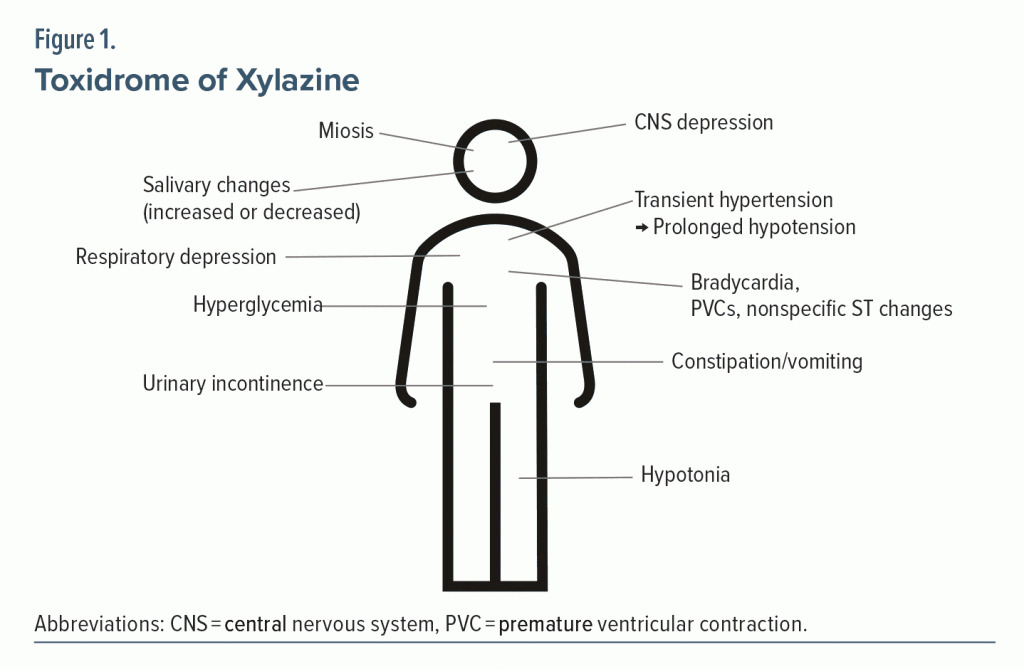ABSTRACT
Importance: Use of xylazine in the United States as an adulterant for drugs of abuse has increased in recent years, thus it is important for health care providers to understand the basic pharmacology and toxidrome of the drug, as well as management options for patients who have overdosed.
Observations: Data obtained from studies between 2006 and 2022 indicate a rapidly increasing incidence of xylazine overdose in the United States, with overdose cases now being seen in 25 states. Hallmark symptoms of xylazine overdose include respiratory depression, bradycardia, hyperglycemia, central nervous system depression, and initial hypertension turning to unstable blood pressure. Xylazine overdose is not reversible with naloxone and requires supportive measures.
Conclusions and Relevance: It is important for health care providers to be aware of presenting symptoms in xylazine overdose so that proper care can be provided. Facilities may consider adding xylazine to their routine toxicology report to aid in patient management and better assess the incidence of xylazine use as an adulterant in a given geographic area.
Prim Care Companion CNS Disord 2023;25(6):22nr03473
Author affiliations are listed at the end of this article.
Xylazine hydrochloride is a potent sedative, muscle relaxant, and analgesic approved for use in veterinary practice either as monotherapy or in combination.1 The drug has been explored for use in humans but was found to be unsuitable, causing marked hypotension. In the early 2000s, xylazine use in humans was seen in Puerto Rico as either a single drug of abuse or a bulking agent or adulterant for other drugs including heroin, cocaine, and fentanyl.2 Bulking agents are adulterants that can be of value to the seller, as they increase the value of a drug or modulate the activity of the drug, either increasing or decreasing its effects. In group therapy sessions conducted with people who use illicit drugs in Philadelphia, users indicated that xylazine added to fentanyl creates a “high” similar to what they experienced using heroin, with a longer lasting euphoria.3
Xylazine is a weak base, and due to its lipophilic nature has a rapid onset of action and undergoes rapid distribution to different tissues.2 It rapidly penetrates the blood-brain barrier, inhibiting neural transmission within the central nervous system, leading to hypotension, sedation, respiratory depression, decreased cardiac output, and analgesia.2,4,5 It is a tricyclic ring similar in structure to clonidine, tricyclic antidepressants, and phenothiazines, and it acts as a potent α2 agonist in both central and peripheral nervous systems.2,4,5 Peripherally, its α2 agonist activity inhibits neurotransmission, decreasing norepinephrine, epinephrine, insulin, and non-esterified fatty acids, while also leading to hyperglycemia.5
METHODS
A literature search was conducted in Google Scholar, PubMed and MEDLINE using the keyword combinations “xylazine, fentanyl” and “xylazine, humans” to identify research conducted using animal models and case studies related to accidental or purposeful human overdose. Only studies published in the English language with a publication date between 2005 and 2022 were considered. Studies were included if they provided novel information about the incidence of xylazine use as an adulterant in nonpharmaceutical fentanyl within the United States or the pharmacokinetics, toxidrome, or treatment for overdose. Fourteen studies conducted in the United States and Puerto Rico were found relevant to our search.
RESULTS
Beginning in 2006, studies began to identify xylazine within the United States associated with nonpharmaceutical fentanyl found in Philadelphia.3 Since that time, its incidence as an adulterant for fentanyl has been increasing. A study3 published in 2008 showed the presence of xylazine associated with the presence of fentanyl in autopsy urine and blood samples from overdose fatalities in Philadelphia between 2006 and 2008. From 2010 to 2019, xylazine detection in unintentional overdose cases rose from 2% to 31%.6 A review of postmortem toxicology reports and death certificates from 2019 implicated xylazine as a cause of death in 1.8% of unintentional fatal drug overdoses across 25 states.7 Of these deaths, xylazine was associated with fentanyl 99.1% of the time.7 A study8 conducted in Philadelphia in 2021 found 63 of 81 fentanyl-positive urine samples contained xylazine (78%); notably, 4 of the 18 urine samples negative for xylazine were found to be false-positive for fentanyl. In a study published in 2021, xylazine was also found in 26 of the 169 towns in the state of Connecticut.5 Another study9 showed a 50% increase in xylazine-related overdose deaths between 2019 and 2020 and estimated a 20-fold increase in prevalence between 2015 and 2020. The study9 collected data from all 4 major US census regions and found prevalence to still be the highest in the Northeast.
Xylazine can cause a wide variety of symptoms as shown in Figure 1,3–8,10,11 but hallmark symptoms include respiratory depression, bradycardia, hyperglycemia, and central nervous system depression leading to coma.4 Additionally, because xylazine is usually coadministered with other drugs of abuse, it can be difficult to identify as a causative agent in drug overdose cases. However, xylazine toxicity is an important etiology to consider in a differential diagnosis because it is not reversible with naloxone and requires additional interventional care and support.6 In chronic xylazine use, patients may present with painful skin ulcers, abscesses, and skin lesions.1 The painful nature of these sites leads to increased xylazine use, particularly at the site of ulceration in an attempt to benefit from the drug’s analgesic affects.1 Notably, these ulcers do not appear just at injection sites and may be reported on non–injection site limbs. One hypothesis about the formation of these abscesses is that the analgesic effect of the drug may contribute to repeated skin scratching while using the drug.10
Earlier pharmacokinetic studies conducted with animals show species-specific dosing is required for effective use as a sedative with duration of action being dose dependent.12 In 2001, an analysis was conducted using blood, urine, and gastric secretions from a patient who had attempted suicide using an intramuscular injection of 75 mL 2% aqueous solution xylazine.4 Results showed that substantial amounts of xylazine were present in the patient’s gastric secretions despite the intramuscular injection, supporting the idea that the one pathway of excretion from the body is through gastric secretions.4 Urinalysis in that study4 was negative for xylazine. This finding can be explained by a later study11 that revealed xylazine to be rapidly metabolized via hydroxylation, dealkylation, C-oxidation, and S-oxidation, yielding 20 phase I and phase II metabolites that are then excreted renally. Further testing showed high concentration of these metabolites in human urine following xylazine intoxication. Analysis of both human and rat urine showed similar relative abundances of each metabolite, supporting urine as an additional pathway for excretion.11
Xylazine’s half-life is related to its rate of breakdown into metabolites, and renal function is not related to the drug’s half-life, as shown in a study13 wherein bilateral renal artery occlusion of anesthetized rabbits failed to significantly alter the pharmacokinetics of the drug. Cytochrome P450 (CYP) 3A was identified as an important enzyme in the rapid metabolism of xylazine, with coadministration of ketamine (broken down by CYP3A) or ketoconazole (a CYP3A inhibitor) significantly reducing its rate of clearance.14 The authors14 maintained that impairment of this enzyme via substrate competition, fever, or impaired liver function may prolong its effects on the body by slowing the rate of xylazine clearance. In patients with unimpaired CYP3A function, the half-life of the drug was shown to be 4.2 minutes, with less than 1% of the drug remaining unchanged after 45 minutes.14
Treatment of xylazine toxicity is supportive, including endotracheal intubation to counteract respiratory depression, fluids to stabilize blood pressure, electrocardiogram monitoring, and urinary catheter placement.2,5 It is important to note that a patient may initially present with hypertension due to initial central α2 receptor antagonism, but as its peripheral blockade of norepinephrine begins to predominate, blood pressure may become hypotensive.4 Dramatic fluctuations in blood pressure can be expected due to these contradictory pathways, so careful monitoring is needed to provide appropriate supportive measures.4 Activated charcoal and gastric lavage can also be used to target xylazine present in gastric secretions.4 Toxicity is associated with xylazine dosage, ranging from 40 to 2,400 mg, although dosage cannot accurately predict fatality due to synergistic activity with drugs acting at similar receptors.2,5
CONCLUSIONS
With data suggesting the incidence of xylazine overdose is increasing in the continental United States, it is important for health care providers to be aware of presenting symptoms in xylazine overdose to quickly identify cases so that proper care can be provided. Additionally, facilities may consider adding xylazine to their routine toxicology report to aid in patient management and better assess the incidence of xylazine use as an adulterant in a given geographic area. At this time, further studies are needed to identify the presence and burden of xylazine use as an adulterant in nonpharmaceutical fentanyl in different regions of the United States beyond the East Coast.
Article Information
Published Online: October 31, 2023. https://doi.org/10.4088/PCC.22nr03473
© 2023 Physicians Postgraduate Press, Inc.
Submitted: December 20, 2022; accepted May 8, 2023.
To Cite: Leconte CE, Sethi R. The appearance of xylazine in the United States as a fentanyl adulterant. Prim Care Companion CNS Disord. 2023;25(6):22nr03473.
Author Affiliations: University of Kansas School of Medicine, Kansas City (Leconte); Department of Psychiatry and Behavioral Sciences, University of Kansas Medical Center, Kansas City (Sethi).
Corresponding Author: Roopa Sethi, MD, Department of Psychiatry and Behavioral Sciences, University of Kansas Medical Center, 3901 Rainbow Blvd, Mail Stop 4015, Kansas City, KS 66160 ([email protected]).
Relevant Financial Relationships: None.
Funding/Support: None.
Clinical Points
- Hallmark symptoms of xylazine overdose include respiratory depression, bradycardia, hyperglycemia, central nervous system depression, and unstable blood pressures.
- Xylazine toxicity is not reversible with naloxone and requires supportive care including endotracheal intubation and careful blood pressure monitoring.
- Urine drug screening is still not routinely performed in many facilities despite rapidly increasing incidence of xylazine overdose.
References (14)

- Torruella RA. Xylazine (veterinary sedative) use in Puerto Rico. Subst Abuse Treat Prev Policy. 2011;6(1):7. PubMed CrossRef
- Ruiz-Colón K, Chavez-Arias C, Díaz-Alcalá JE, et al. Xylazine intoxication in humans and its importance as an emerging adulterant in abused drugs: A comprehensive review of the literature. Forensic Sci Int. 2014;240:1–8. PubMed CrossRef
- Wong SC, Curtis JA, Wingert WE. Concurrent detection of heroin, fentanyl, and xylazine in seven drug-related deaths reported from the Philadelphia Medical Examiner’s Office. J Forensic Sci. 2008;53(2):495–498. PubMed CrossRef
- Hoffmann U, Meister CM, Golle K, et al. Severe intoxication with the veterinary tranquilizer xylazine in humans. J Anal Toxicol. 2001;25(4):245–249. PubMed CrossRef
- Nunez J, DeJoseph ME, Gill JR. Xylazine, a veterinary tranquilizer, detected in 42 accidental fentanyl intoxication deaths. Am J Forensic Med Pathol. 2021;42(1):9–11. PubMed CrossRef
- Johnson J, Pizzicato L, Johnson C, et al. Increasing presence of xylazine in heroin and/or fentanyl deaths, Philadelphia, Pennsylvania, 2010–2019. Inj Prev. 2021;27(4):395–398. PubMed CrossRef
- Kariisa M, Patel P, Smith H, et al. Notes from the field: xylazine detection and involvement in drug overdose deaths– United States, 2019. MMWR Morb Mortal Wkly Rep. 2021;70(37):1300–1302. PubMed CrossRef
- Korn WR, Stone MD, Haviland KL, et al. High prevalence of xylazine among fentanyl screen-positive urines from hospitalized patients, Philadelphia, 2021. Clin Chim Acta. 2021;521:151–154. PubMed CrossRef
- Friedman J, Montero F, Bourgois P, et al. Xylazine spreads across the US: a growing component of the increasingly synthetic and polysubstance overdose crisis. Drug Alcohol Depend. 2022;233:109380. PubMed CrossRef
- Rodríguez N, Vargas Vidot J, Panelli J, et al. GC-MS confirmation of xylazine (Rompun), a veterinary sedative, in exchanged needles. Drug Alcohol Depend. 2008;96(3):290–293. PubMed CrossRef
- Meyer GM, Maurer HH. Qualitative metabolism assessment and toxicological detection of xylazine, a veterinary tranquilizer and drug of abuse, in rat and human urine using GC-MS, LC-MSn, and LC-HR-MSn. Anal Bioanal Chem. 2013;405(30):9779–9789. PubMed CrossRef
- Whitlock J. The use of xylazine hydrochloride in free roaming and wild mammals. Iowa State Univ Vet. 1974;36(3):109–110.
- Garcia-Villar R, Toutain PL, Alvinerie M, et al. The pharmacokinetics of xylazine hydrochloride: an interspecific study. J Vet Pharmacol Ther. 1981;4(2):87–92. PubMed CrossRef
- Lavoie DS-G, Pailleux F, Vachon P, et al. Characterization of xylazine metabolism in rat liver microsomes using liquid chromatography-hybrid triple quadrupole-linear ion trap-mass spectrometry. Biomed Chromatogr. 2013;27(7):882–888. PubMed CrossRef
Save
Cite
Advertisement
GAM ID: sidebar-top





